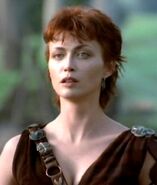The Morrígan or Mórrígan, also known as Morrígu, is a figure from Irish mythology. The name is Mór-Ríoghain in Modern Irish. It has been translated as "great queen" or "phantom queen".
The Morrígan is mainly associated with war and fate, especially with foretelling doom, death or victory in battle. In this role, she often appears as a crow, the badb. She incites warriors to battle and can help bring about victory over their enemies. The Morrígan encourages warriors to do brave deeds, strikes fear into their enemies and is portrayed washing the bloodstained clothes of those fated to die. She is most frequently seen as a goddess of battle and war and has also been seen as a manifestation of the earth- and sovereignty-goddess, chiefly representing the goddess's role as guardian of the territory and its people.
The Morrígan is often described as a trio of individuals, all sisters, called "the three Morrígna". Membership of the triad varies; sometimes it is given as Badb, Macha and Nemain while elsewhere it is given as Badb, Macha and Anand (the latter is given as another name for the Morrígan). It is believed that these were all names for the same goddess. The three Morrígna are also named as sisters of the three land goddesses Ériu, Banba and Fódla. The Morrígan is described as the envious wife of The Dagda and a shape-shifting goddess, while Badb and Nemain are said to be the wives of Neit. She is associated with the banshee of later folklore.
The Morrígan is said to be the wife of the Dadga. She is associated with the banshee of later folklore.
Myths & Legends[]
She is mainly associated with war, fate and especially with foretelling doom, victory or death in battle. In this role, she takes the form of a crow, the badb. She would ignite the will to battle and can help bring about victory over their enemies. The Morrígan encourages warriors to do brave deeds and she strikes fear into their enemies. She is portrayed washing the bloodstained clothes of those fate to die (a behaviour similar to the bean nighe). She also has some has some connection with sovereignty, the land and livestock.
In modern times she is often called a "war goddess" and has also been seen as a manifestation of the earth- and sovereignty goddess, chiefly representing the goddess' role as guardian of the territory and its people.
Morrigan as a Trio[]
The Morrígan is often described as a trio of individuals; all sisters, called "the three Morrígna". Membership of the triad varies - sometimes it is given as Badb, Macha and Nemain while elsewhere it is given as Badb, Macha and Anand (the latter is given as another name for the Morrígan). It is believed that these were all names for the same goddess. The three Morrígna are also named as sisters of the three land goddesses Ériu, Banba and Fódla. , while Badb and Nemain are said to be the wives of Neit.
Etymology[]
There is some disagreement over the true meaning of the Morrígan's name as to whether it means Phantom or Monster. Mor is generally agreed by current day scholars to be the Indo-European root cognate for something bad or evil usually death and is the word that evolved into other words such as Mortal, Mortality, Mortuary, Monsters, etc. Connoting terror, cognate with the Old English maere (which survives in the modern English word "nightmare") and the Scandinavian mara and the Old Russian "mara" ("nightmare"); while rígan translates as 'queen'. such as the English word reign. This can be reconstructed in Proto-Celtic as *Moro-rīganī-s. Accordingly, Morrígan is often translated as "Phantom Queen" and "Monster Queen". These two meanings are the derivations generally favored in current scholarship.

